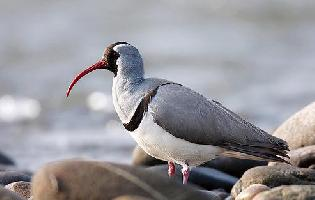
Váhy a míry
| Délka | od 38 do 41 cm |
|---|
Popis zvířete
The Ibisbill (Ibidorhyncha struthersii) is a distinctive and enigmatic bird species, primarily known for its unique appearance and specialized habitat preferences. This bird belongs to the family Ibidorhynchidae, and it is the sole member of its genus, Ibidorhyncha, making it quite a unique species in the avian world. The Ibisbill is native to the mountainous regions of Central and South Asia, thriving along the rocky shores of fast-flowing rivers and streams at elevations ranging from about 1,500 to 4,400 meters.One of the most striking features of the Ibisbill is its remarkable bill, which is long, curved downwards, and resembles that of an ibis, hence the name. This adaptation is particularly suited to its feeding habits, allowing it to forage for aquatic invertebrates in the crevices of rocks and in the water. The bill is bright red, providing a vivid contrast against its predominantly grey and black plumage. The adult Ibisbill is a sight to behold, with a sleek, slate-grey body, a white belly, and distinctive black bands across its face, neck, and breast. Its legs are also a striking red, matching the bill, and its eyes are dark, adding to its charismatic appearance.
The Ibisbill measures approximately 40-43 cm in length, with a wingspan that can reach up to 56-61 cm. Despite its somewhat bulky appearance, it is an agile bird, especially in its natural habitat of stony riverbanks and gravel bars, where it walks with a measured gait, searching for food. Its diet primarily consists of aquatic invertebrates, including insects, crustaceans, and small mollusks.
Breeding typically occurs in the spring and early summer. The Ibisbill is monogamous, with pairs forming strong bonds. The nest is a simple scrape in the ground, often lined with small stones and located near the water's edge, where it is camouflaged against predators. The female usually lays 2-4 eggs, which both parents incubate. The chicks are precocial, meaning they are relatively mature and mobile from the moment of hatching. This is essential for their survival in the dynamic and potentially hazardous riverine environment.
Despite its striking appearance, the Ibisbill is a shy and elusive bird, often difficult to spot against the rocky landscapes it inhabits. It is known for its quiet demeanor, although it can emit a sharp, whistled call, especially when alarmed or communicating with its mate.
The Ibisbill's range extends across several countries, including Nepal, Bhutan, India, China, and parts of Kazakhstan and Russia. While it is not currently considered globally threatened, its populations are affected by habitat degradation, including pollution, dam construction, and increased human disturbance. Conservation efforts are crucial to ensure the preservation of its natural habitat and the survival of this remarkable species.
In summary, the Ibisbill is a fascinating and unique bird, both in appearance and ecology. Its specialized adaptations to a life along cold, fast-flowing rivers in high-altitude regions make it a remarkable example of evolutionary niche-filling. Despite its somewhat cryptic nature, the Ibisbill continues to captivate birdwatchers and nature enthusiasts fortunate enough to observe it in the wild, symbolizing the untouched beauty of the world's mountainous river ecosystems.
Mapa výskytu

Nové fotografie zvířat
Top 10 zvířat
- Chinese water dragon (Physignathus cocincinus)
- Galápagos tortoise (Geochelone nigra complex)
- Dolphin gull (Leucophaeus scoresbii)
- Japanese macaque (Macaca fuscata)
- Colombian red howler (Alouatta seniculus)
- Sea urchins (Echinoidea)
- Moustached guenon (Cercopithecus cephus)
- Diana monkey (Cercopithecus diana)
- Common reed warbler (Acrocephalus scirpaceus)
- Common house mosquito (Culex pipiens)